
Editorial
Austin Med Sci. 2022; 7(2): 1069.
Radiological Findings More Important and Reliable in the Diagnosis of Skeletal Fluorosis
Choubisa SL*
Department of Advanced Science and Technology, National Institute of Medical Science and Research, NIMS University Rajasthan, India
*Corresponding author: Choubisa SL, Department of Advanced Science and Technology, National Institute of Medical Science and Research, NIMS University Rajasthan, Jaipur, Rajasthan 303121, India
Received: August 15, 2022; Accepted: September 08, 2022; Published: September 15, 2022
Abstract
Skeletal fluorosis is the resultant of prolonged chronic fluoride exposure through fluoride containing water and food and /or industrial fluoride emission. In this disease, due to pathological changes in various bones of the body, many types of physical deformities develop which are more painful and unbearable. These bony deformities remain in man throughout his life. There is no cure available for these fluoride-induced disorders yet. Among these deformities, the most common bone deformities in humans are bending at the waist (kyphosis) and curvature of the lower extremities (genu-varum and genu-valgum). In severe state of skeletal fluorosis, neurological complications such as paraplegia and quadriplegia are also prevalent in human population. In fact, these are the crippling deformities and can be easily recognised by necked eyes. But many times mistakes are made in identifying skeletal fluorosis in its early stages. However, radiological study makes the diagnosis of skeletal fluorosis easier, which is also more important and reliable. Because even mild fluorideborne effects, such as periosteal exostosis, osteosclerosis, osteoporosis, and osteophytosis can be easily detected in X-rays of diverse bones of skeletal. However, the presence of fluoride-induced calcification of the interosseous membrane between radius and ulna bones of upper limbs or forearms is the most ideal or correct diagnostic feature or sign of skeletal fluorosis. In present editorial, besides the different forms of crippling deformities, various fluorideinduced radiological changes in diverse bones of subjects afflicted with mild to severe skeletal fluorosis have also been focussed which are more important, useful, and reliable in the diagnosis of skeletal fluorosis in humans.
Keywords: Bones; Crippling deformities; Fluoride; Genu-valgum; Genu-varum; Kyphosis; Paraplegia; Periosteal exostosis, Osteophytosis; Osteoporosis; Osteosclerosis; Quadriplegia; Radiology; Skeletal fluorosis; X-rays
Introduction
It is well known that excessive ingestion or inhalation of fluoride for long duration is injurious to health and causes a dreaded fluorosis disease in both humans [1-5] and diverse species of domestic animals [6-13]. The available sources of fluoride to man and animals are: drinking water, vegetation and crops grown on fluorotic soils and water, beverages, rock salts, certain edible marine animals, fluoride rich phosphate feed supplements, mineral mixture, medicines, cosmetics, dust in air and certain industrial processes [1,6]. However, the principal sources of fluoride exposure in human and animals are the fluoridated drinking water and industrial fluoride emission from diverse industrial activities such as zinc smelter, superphosphate fertilizer plants, rock phosphate mining, chemical fertilizer industries, bricks kilns, cement production, etc. Although, perennial surface waters such as ponds, reservoirs, lakes, dams, rivers, streams etc. are also sources of drinking water but these are mostly free from the fluoride contamination or have traces of fluoride or 0.01–0.3 ppm [1,14-16]. In fact, fluorosis develops in humans only when the amount of fluoride in drinking water is found to be more than 1.5 ppm [1].
If fluorosis develops from drinking of fluoridated water, then it is called hydrofluorosis. Similarly, fluorosis caused by industrial fluoride pollution then it is called neighbourhood or industrial fluorosis. But the disorders or anomalies develop in the body caused by these two types of fluorosis are almost the same in both man and animals [17,18].
After the ingestion or inhalation of F from different sources of fluoride exposure, it absorbed by digestive and /or respiratory systems and then finally reaches to various organs through blood circulatory system in the body. More than 50% absorbed F is excreted from the body through excretory products and perspiration, while rest of F is retained in the body where it accumulates gradually in the various organs. However, the maximum bio-accumulation of fluoride occurred in the calcified tissues, bones and teeth as compared to their counter parts. In general, the process of fluoride bio-accumulation is found to be higher in children and immature animals [19-21].
Though, fluoride is not essential element in the process of growth and development in human and animals and is also undesirable substance in animal feed [22,23]. But it has a vital contribution in the formation or mineralization of teeth and dental enamel and prevents the dental caries [1,6]. Nevertheless, the accumulation of fluoride in various organs adversely affects the physiological and metabolic activities, due to which many types of reversible and irreversible pathological changes are developed. These fluoride-induced pathological changes or anomalies are collectively known as fluorosis [1]. Those changes appeared clinically in hard tissues, teeth (dental fluorosis) and bones (skeletal fluorosis) are permanent, irreversible, and untreatable and they could be easily identified visually [1,6]. But other fluoride-induced disorders in soft organs (non-skeletal fluorosis) are however, reversible and disappeared when check the fluoride exposure.
Skeletal Fluorosis
An excessive fluoride intake alters the equilibrium between the formation and the resorption of bone. This physiological change is accomplished by the involvement of certain regulatory determinants and signalling pathways, thereby leading to various bone or skeletal deformities known as “skeletal fluorosis”, which is very painful and more dangerous than other forms of fluorosis in both man and animals. Due to excessive accumulation of fluoride in diverse bones, people suffer with crippling deformities, such as hunch-back (kyphosis) and bow legs (genu-varum), and some are bedridden. In severe state of skeletal fluorosis people also suffer with scissorshaped knock-knee (genu-valgum) leg deformities and neurological complications, such as paraplegia and quadriplegia [24,25]. In general, these bone abnormalities are easily recognised visually. These crippling deformities are more prevalent or common in the subjects of the higher age groups when in the drinking water fluoride concentration is ≥1.5 ppm [24,25].
The excess accumulation of fluoride in muscles also diminishes or restricts movements and the condition leads to becoming disabled including with crippling. As the fluoride concentration in the drinking water increases the skeletal fluorosis becomes more severe and may develop even in children and adolescents as well as in adult individuals. However, severity or magnitude of skeletal fluorosis is much more depend on fluoride concentration in drinking water and its duration and intake frequency or the density if its bioaccumulation in bones [26]. Apart from these chemical constituents in drinking water, food nutrients, ethnic groups, age, sex, individual fluoride susceptibility or tolerance, genetics, etc. are also responsible for the severity of fluorosis [27-33].
Radiological Findings in the Diagnosis of Skeletal Fluorosis
Skeletal fluorosis is highly significant since it diminishes mobility at a very early age by gradually producing various changes in bones such as periosteal exostosis, osteosclerosis, osteoporosis, and osteophytosis [24,25,34-39]. These changes appear clinically in the form of vague aches and pains in the body and joints and the changes can be seen and identified in the radiographs or X-rays of various bones of skeletal of fluorosed subjects (Figures 1-6). Though, skeletal fluorosis can be identified on the basis of presence of these fluoride-induced radiological changes in diverse bones. But it is not necessary that these changes are present in mild form skeletal fluorosis. Therefore, X-ray of the radius-ulna bones of forearm is more important and helpful for the diagnosis of skeletal fluorosis because interosseous membrane between them is the first to initiate fluoride-induced calcification which can be easily detected on X-ray film (Figure 3). In fact, calcification of interosseous membrane of radius-ulna bones of forearms is the most ideal diagnostic feature for evidence of skeletal fluorosis [40]. Although skeletal fluorosis can be inferred on the basis of crippling deformities, nevertheless, radiological findings are more important, helpful, and reliable for the correct diagnosis of skeletal fluorosis.
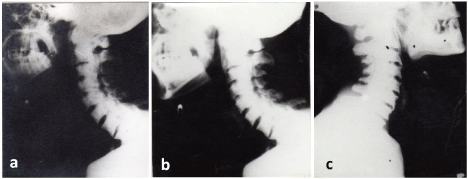
Figure 1a-c: Radiographs of cervical spines of subjects having mild (a), moderate (b), and severe (c) skeletal fluorosis showing progressive osteosclerosis,
osteophytosis, and calcification of thyroid cartilage.
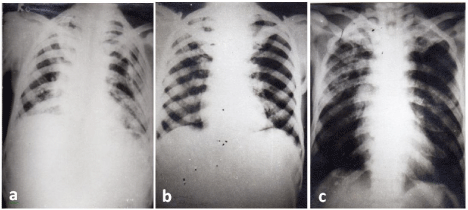
Figure 2a-c: Radiographs of chests of subjects having mild (a), moderate (b), and severe (c) skeletal fluorosis showing a peculiar contrast between the chalkywhite
bony cage and translucent lungs, irregular thickening of ribs and clavicles, and calcification of muscles.
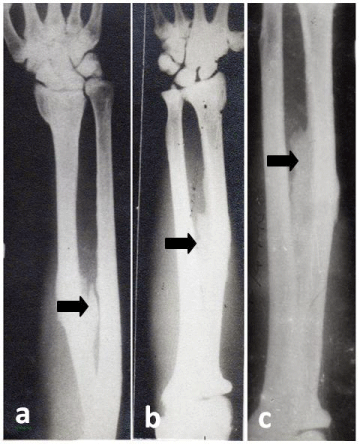
Figure 3a-c: Radiographs of radius-ulna bones of forearms of subjects having
mild (a), moderate (b), and severe (c) skeletal fluorosis showing progressive
osteoporosis, roughening and thickening of periosteal surface, periosteal
bone formation along the insertion of tendons, and ligaments. Calcification
of interosseous membrane (arrow) between radius and ulna bones indicating
skeletal fluorosis.
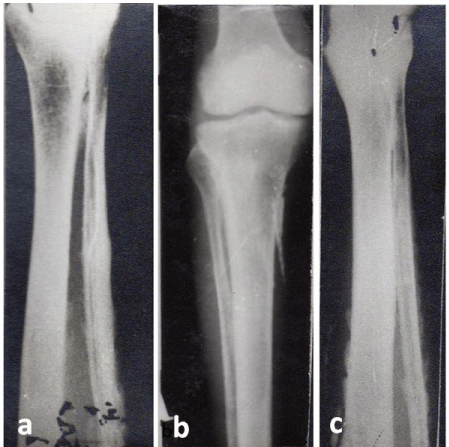
Figure 4a-c: Radiographs of tibia-fibula bones of subjects having varying
grades of chronic fluoride intoxication (a-c) showing progressive osteoporosis,
roughening and thickening of periosteal surface, periosteal bone formation
along the insertion of tendons, and ligaments.
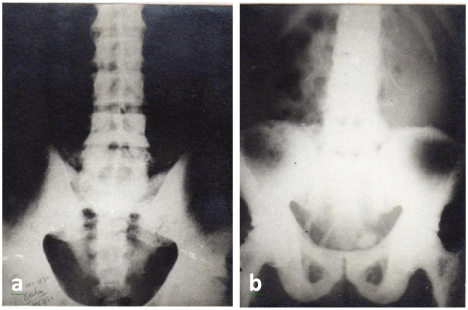
Figure 5a & b: Radiographs lumbo-dorsal spines or vertebrae of subjects
having moderate (a) and very severe (b) skeletal fluorosis showing diverse
progressive changes in spines or vertebrae markedly sclerotic with irregular
new bone formation, considerable lipping, and osteophytosis. Interspirous
and other spinal ligaments also showed calcification in severe skeletal
fluorosis (b).
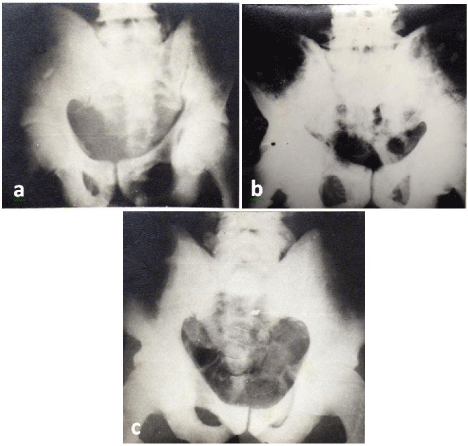
Figure 6a-c: Radiographs of pelvic bones subjects having mild (a), moderate
(b), severe (c) skeletal fluorosis showing diverse progressive changes as
sclerosis of the iliac crests and ischial tuberosities, pelvic bones appeared
dense with loss of bone detail, osteophytic changes, ossification of sarcospinous
and sarco-tuberous ligaments.
Acknowledgements
The author thanks to Dr. Darshana Choubisa, Associate Professor, Department Prosthodontics, Geetanjali Dental and Research Institute Udaipur, Rajasthan 313002, India for cooperation.
References
- Adler P, Armstrong WD, Bell ME, Bhussry BR, Büttner W, Cremer H-D, et al. Fluorides and human health. World Health Organization Monograph Series No. 59. Geneva: World Health Organization, 1970.
- Choubisa SL, Sompura K, Bhatt SK, Choubisa DK, Pandya H, Joshi SC, et al. Prevalence of fluorosis in some villages of Dungarpur district of Rajasthan. Indian J Environ Health, 1996; 38: 119-126.
- Choubisa SL, Choubisa DK, Joshi SC, Choubisa L. Fluorosis in some tribal villages of Dungarpur district of Rajasthan, India. Fluoride. 1997; 30: 223-228.
- Choubisa SL. Fluorosis in some tribal villages of Udaipur district (Rajasthan). J Environ Biol. 1998; 19: 341-352.
- Choubisa SL. Chronic fluoride intoxication (fluorosis) in tribes and their domestic animals. Intl J Environ Stud. 1999; 56: 703-716.
- Swarup D, Dwivedi SK. Environmental pollution and effect of lead and fluoride on animal health. New Delhi: Indian Council of Agricultural Research; 2002.
- Choubisa SL. Some Observations on Endemic Fluorosis in Domestic Animals in Southern Rajasthan (India). Veterinary Research Communications. 2004; 23: 457-465.
- Choubisa SL. Fluoride toxicity in domestic animals in Southern Rajasthan. Pashudhan, 2000; 15: 5.
- Choubisa SL. Fluoridated ground water and its toxic effects on domesticated animals residing in rural tribal areas of Rajasthan, India. International Journal of Environmental Studies. 2007; 64: 151-159.
- Choubisa SL. Osteo-dental fluorosis in horses and donkeys of Rajasthan, India. Fluoride. 2010; 43: 5-10.
- Choubisa SL. Fluorosis in dromedary camels of Rajasthan, India. Fluoride, 2010; 43: 194-199.
- Choubisa SL. Chronic fluoride exposure and its diverse adverse health effects in bovine calves in India: an epitomised review. Glob J Biol Agric Health Sci. 2021;10:1-6.
- Choubisa SL. A brief and critical review of chronic fluoride poisoning (fluorosis) in domesticated water buffaloes (Bubalus bubalis) in India: focus on its impact on rural economy. J Biomed Res Environ Sci. 2022; 3: 96-104.
- Choubisa SL. A brief and critical review on hydrofluorosis in diverse species of domestic animals in India. Environmental Geochemistry and Health. 2017; 40: 99-114.
- Choubisa SL A brief and critical review of hydrofluorosis in Rajasthan, India. Fluoride. 2018; 51: 13-33.
- Choubisa SL, Choubisa D. Status of industrial fluoride pollution and its diverse adverse health effects in man and domestic animals in India. Environmental Science and Pollution Research. 2016; 23: 7244-7254.
- Choubisa SL, Choubisa D. Neighbourhood fluorosis in people residing in the vicinity of superphosphate fertilizer plants near Udaipur city of Rajasthan (India). Environmental Monitoring and Assessment. 2015; 187: 1-6.
- Choubisa SL. Industrial fluorosis in domestic goats (Capra hircus), Rajasthan, India. Fluoride, 2015; 48: 105-115.
- Choubisa SL. Status of chronic fluoride exposure and its adverse health consequences in the tribal people of the scheduled area of Rajasthan, India. Fluoride. 2022; 55: 8-30.
- Choubisa SL, Choubisa D, Choubisa A. Fluoride contamination of groundwater and its threat to health of villagers and their domestic animals and agriculture crops in rural Rajasthan, India. Environ Geochem Health. 2022. doi.org/10.1007/s10653-022-01267-z.
- Choubisa SL. Fluoride toxicosis in immature herbivorous domestic animals living in low fluoride water endemic areas of Rajasthan, India: an observational survey. Fluoride. 2013; 46: 19-24.
- SCHER. Opinion on critical review of any new evidence on the hazard profile, health effects, and human exposure to fluoride and the fluoridating agents of drinking water. 2011; 1-59. doi:10.2772/38897.
- Alexander J, Autrup H, Bard D, Carere A, Costa LG, Cravedi JP, et al. Opinion of the scientific panel on contaminants in the food chain on a request from the commission related to fluorine as undesirable substance in animal feed. The EFSA J. 2004; 100: 1-22. http://www.efsa.eu.int 1/22.
- Choubisa SL. Endemic fluorosis in southern Rajasthan (India). Fluoride, 2001; 34: 61-70.
- Choubisa SL, Choubisa L, Choubisa DK. Endemic fluorosis in Rajasthan. Indian J Environ Health. 2001; 43: 177-89.
- Choubisa SL, Choubisa A. A brief review of ideal bio-indicators, bio-markers and determinants of endemic of fluoride and fluorosis. J Biomed Res Environ Sci. 2021; 2: 920-925.
- Choubisa SL, Choubisa L, Sompura K, Choubisa D. Fluorosis in subjects belonging to different ethnic groups of Rajasthan. J Commun Dis. 2007; 39(3): 171-177.
- Choubisa SL, Choubisa L, Choubisa D. Osteo-dental fluorosis in relation to nutritional status, living habits and occupation in rural areas of Rajasthan, India. Fluoride. 2009; 42: 210-215.
- Choubisa SL, Choubisa L, Choubisa D. Osteo-dental fluorosis in relation to age and sex in tribal districts of Rajasthan, India. J Environ Sci Engg. 2010; 52: 199-204.
- Choubisa SL. Natural amelioration of fluoride toxicity (fluorosis) in goats and sheep. Curr Sci. 2010; 99: 1331-1332.
- Choubisa SL, Choubisa L, Choubisa D. Reversibility of natural dental fluorosis. Intl J Pharmacol Biol Sci. 2011; 5: 89-93.
- Choubisa SL, Mishra GV, Sheikh Z, Bhardwaj B, Mali P, Jaroli VJ. Food, fluoride, and fluorosis in domestic ruminants in the Dungarpur district of Rajasthan, India. Fluoride. 2011; 44: 70-76.
- Choubisa SL. Osteo-dental fluorosis in relation to chemical constituents of drinking waters. J Environ Sci Engg. 2012; 54: 153-158.
- Azar HA, Nucho CK, Bayyuk SI, Bayyuk WB. Skeletal sclerosis due to chronic fluoride intoxication. Case from an endemic area of fluorosis in the region of Persian Gulf. Ann Inter Med. 1961; 55: 193.
- Chawala S, Kanwar K, Baggar OP, Anand D. Radiological Changes in endemic fluorosis. J Assoc Physicians India. 1965; 13: 222-228.
- Choubisa SL. Radiological skeletal changes due to chronic fluoride intoxication in Udaipur district, Rajasthan. Poll Res. 1996; 15: 227-229.
- Jolly SS, Singh BM, Mathur OC. Endemic fluorosis in Punjab (India). The American journal of medicine. 1969; 47: 553-563.
- Teotia M, Teotia SP, Kunwar KB. Endemic skeletal fluorosis. Archives of Disease in Childhood. 1971; 46: 686-691.
- Choubisa SL. Toxic effects of fluoride on human bones. Adv Pharmacol Toxicol. 2012; 13: 9-13.
- Choubisa SL. The diagnosis and prevention of fluorosis in humans (editorial). J Biomed Res Environ Sci. 2022; 3: 264-267.